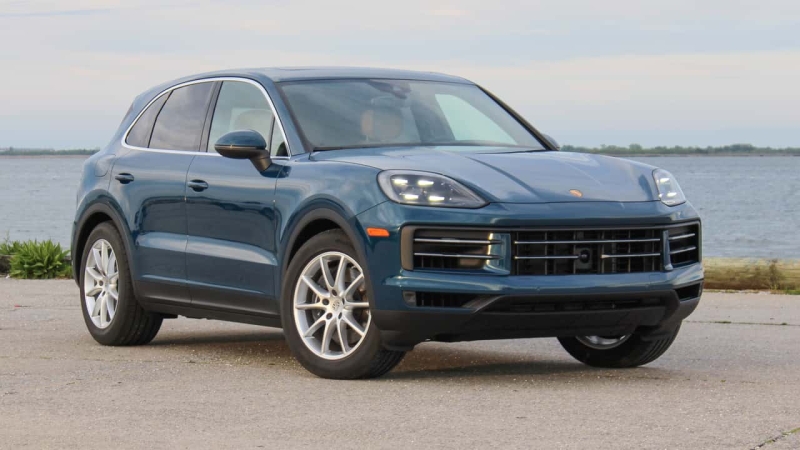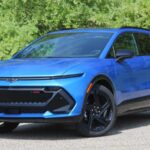More enjoyable to drive than its competition, the Cayenne remains the go-to SUV for the practical enthusiast, even in its base form.
The world was a different place when the original Porsche Cayenne hit dealers in 2002. The internet was barely a thing for most Americans, Ferrari’s single-clutch paddle shifters were considered cutting-edge, and the term “performance SUV” hadn’t been invented.
The Cayenne changed the SUV landscape, giving enthusiasts hope that big, useful utility vehicles could also evoke joy behind the wheel. And 22 years later, even the base V-6-powered Cayenne is proof that practicality and fun aren’t mutually exclusive.
| Quick Specs | 2024 Porsche Cayenne |
| Engine | Turbocharged 3.0-Liter V-6 |
| Transmission | Eight-Speed Automatic |
| Output | 348 Horsepower / 368 Pound-Feet |
| 0-60 MPH | 5.4 Seconds |
| Base Price / As-Tested Price | $79,200 / $96,390 |
Spotting a 2024 Cayenne is tough unless you know what to look for. Its overall design appears nearly identical to the outgoing model, with only minor changes to things like the headlights, taillights, and bumpers. Only the most eagle-eyed will spot changes like the reshaped fenders and hoodline. The old Cayenne wasn’t an ugly car, and this model continues the trend with sleek, sporty lines reminding you that, yes, this is still a Porsche.
The easiest way to spot a 2024 model is to peek inside. The cabin’s gone through an extensive revision that’s heavy on the tech. In front of the steering wheel sits a new 12.6-inch curved digital display that acts as the gauge cluster. It pairs with a 12.3-inch infotainment screen in the center of the dash. Between the two screens is where you’ll find the tiny gear selector, a design borrowed from the 918 Spyder hypercar.
Things get more controversial farther down the center stack. The two columns of buttons flanking either side of the shifter are gone, replaced by a single cluster of buttons that include rockers for climate control and a knob for volume control. Other items, like seat heating and climate functions, are controlled by buttons. But they’re not normal buttons, nor are they touch-sensitive buttons. When you press down on any button, the entire cluster of buttons moves down, as if it were just one huge physical button.
It’s a strange middle ground that aims to draw the line between the last-gen car’s touch-sensitive, haptic-feedback buttons (which, presumably, everyone hated) and individual physical buttons, which would probably cost a lot more to make. The design takes a bit to get used to, but you forget about it after a few hours. The resulting fingerprint-covered buttons are tougher to ignore, however.
The rest of the interior is a lovely place to spend time. The seats are comfortable, supportive, and provide an extremely wide range of adjustability. It’s one of the few driver’s seats where I don’t immediately hit the lowest-to-the-floor setting while trying to find my optimal driving position. Everything you touch feels solid, well-built, and expensive. We’d recommend steering away from the Mojave Beige interior color found in our tester, though. It might be a nice pairing for the Montego Blue Metallic exterior paint, but it scuffs easily and too closely resembles the color of human skin.
The turbocharged 3.0-liter V-6 under the hood is a similarly nice thing, with good initial pickup and consistent torque delivery. It’s not an especially memorable engine, but it’s effective and mostly unobtrusive. Same goes for the transmission, a smooth-shifting eight-speed torque converter that’s standard across the range. The Cayenne remains the only combustion-powered vehicle in Porsche’s lineup not to receive the company’s holy PDK, but for good reason: The traditional automatic allows for a towing capacity of 7,700 pounds, even for this base model. Plenty for getting your race car and trailer to the track and back.
Even when it’s not pulling a big trailer, the Cayenne impresses. This SUV stands tall as the best-handling, most satisfying vehicle in its segment, and it’s not even close. Nowhere else can you find a base-model car this size that delivers as much joy to the person behind the wheel. It’s no 911, obviously, but for something this tall weighing 4,678 pounds, it’s a treat.
Steering feel is one of the most noticeable ways to draw a connection between Porsche’s sports car and its big SUV; the Cayenne’s steering rack is nearly as feelsome as you’d find in a new 911 Carrera. A more-distant sense of road feel and different choices with bushing materials stop the Cayenne’s rack from feeling truly like a sports car, but it’s certainly the best steering you’ll get in a car shaped like this. Rear-wheel steering, a $1,280 option, further improves agility at low speeds, effectively shortening the wheelbase so that three-point turns are kept to a minimum. If all you’re doing is commuting to work, though, you can safely skip it.
The tradeoff for the Cayenne’s superior handling is a noticeably stiff ride. Even in the standard adaptive suspension’s softest mode, more bumps come into the cabin versus something like a Genesis GV80 or Volvo XC90. Our tester had the $2,390 optional air springs, which delivered smooth, settled body control and several ride heights to help with things like fuel efficiency and off-roading. But even with the air ride, don’t expect a truly luxurious experience.
The 2024 Cayenne starts at $80,850 including destination, nearly 10 percent more than before. Porsche justifies the increase by adding a bunch of previously optional items as standard. Things like variable steering, heated front seats, wireless phone charging, memory seats, and comfort access now come included with every Cayenne.
Still, there’s no such thing as a base Porsche. Like any new Cayenne you’ll find on the dealer lot, this test vehicle arrived stacked with options—more than $15,000 worth. Depending on where you live, you might be able to get away without the air suspension. We’d also be fine without the two-tone leather interior and the Sport Chrono package, priced at $4,180 and $1,110, respectively. The ventilated seats ($850) and the premium package ($3,590) are worth it, though. That package gets you things like a Bose sound system, adaptive cruise control, heated rear seats, and a panoramic glass roof.
No matter which options it’s equipped with, the 2024 Cayenne is a lovely machine that checks a lot of boxes. It’s a good-looking car that’s quick enough for most people, and more enjoyable to drive than its competitors. Sure, it’s a bit more expensive than some vehicles in its segment, but you can feel where your money is going as soon as you sit inside and start driving.
Competitors
- BMW X5
- Land Rover Range Rover Sport
- Genesis GV80
Get the best news, reviews, columns, and more delivered straight to your inbox, daily. Sign up For more information, read our
Privacy Policy and Terms of Use.
Gallery: 2024 Porsche Cayenne Review
2024 Porsche Cayenne
Engine Turbocharged 3.0-Liter V-6
Output 348 Horsepower / 368 Pound-Feet
Transmission Eight-Speed Automatic
Drive Type All-Wheel Drive
Speed 0-60 MPH 5.4 Seconds
Maximum speed 154 Miles Per Hour
Weight 4,678 Pounds
Efficiency 17 City / 23 Highway / 19 Combined
Seating Capacity 5
Towing 7,700 Pounds
Cargo Volume 60.3 / 26.9 Cubic Feet
On Sale Now
Base Price $79,200
As-Tested Price $96,390



